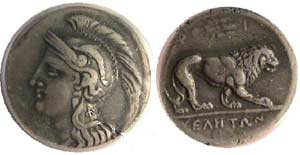The minting of coins spread rapidly from Lydia to the city states of ancient Greece. Around 600 BC , the island of Aegina produced what are believed to be the first Greek coins. These coins were known as silver drachmae and obols and depicted a turtle on the reverse, the symbol of Aegina.
The nearby Greek city state of Cornith soon followed Aegina and produced drachmae coins with the legendary figure of the winged horse Pegasus on the reverse.
The largest of the Greek city states was Athens which around 610 BC began producing very artistic coins often featuring an amphora or wine vessel design.
Alexander the Great (336-323 B.C.) established the practice of coinage throughout the Hellenic empires. His successors introduced portraits as a regular feature of their coinage designs thereby recording for posterity many images of ancient kings and rulers.


No comments:
Post a Comment